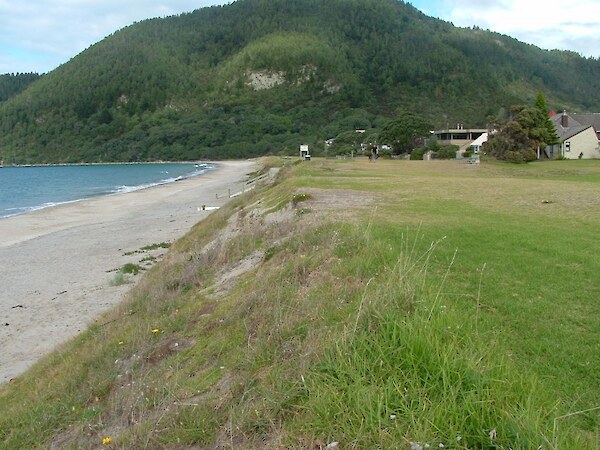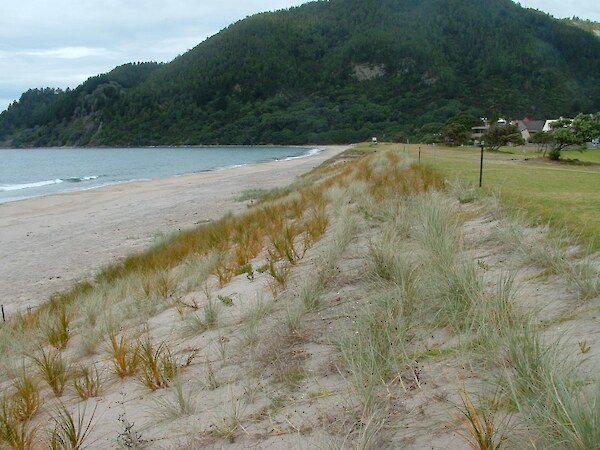Approaches to dune restoration have developed considerably in the past 20 years in New Zealand. Historically, hectares of coastal land was planted with exotic marram grass on an almost cropping- based planting regime - now the approach is more site specific, involving local people and local plants with a more long-term understanding of the dynamics of New Zealand coastal dune systems.
General guidelines are provided below, modified from Community-based Dune Management for the Mitigation of Coastal Hazards and Climate Change Effects (Dahm et al, 2005). Further information is available in our resource centre.
Impacts
When carrying out dune restoration work its important to consider the following impacts that may have occurred or be occurring at your site:
- Removal of dune and lowland forests from back dune areas
- Wind erosion damage associated with the destruction or modification of stabilising native dune vegetation (e.g. from foot or vehicle traffic, animal browsing etc)
- Modification of dunes associated with coastal subdivision (e.g. compacting, topped with grass or hard surfaces)
- Damage to native sand binding vegetation
- Displacement of native dune vegetation by exotic species
- Coastal structures such as storm water drains, groynes
- Other activities such as sand extraction or river mouth engineering
Common elements
Dune restoration and management programs may have a variety of aims. Common elements of dune restoration plans are:
- Basic site considerations
- Earthworks and dune reshaping
- Plant and/or enhancing foredune vegetation
- Plant and/or enhancing backdune vegetation
- Access and vehicle management
- Weed and pest control
- Information and education
- Monitoring and maintenance
Basic site considerations
Dune management should generally only be considered at sites where dunes are or were a natural element of the coastal environment. You can find this out by looking at historical information, photos or similar local beach environments. It is important that there is sufficient space between development (i.e. roads, carparks) and the sea to form a sustainable dune (or part dune). If the space is inadequate, it will be necessary to create more space before proceeding with dune restoration. At most developed sites, the available space may be sufficient for a sustainable dune (at least in the short-medium term) but will probably not be adequate to provide complete protection from the worst practical erosion, including climate change effects. In this situation, dune management must be complemented with other hazard management options - talk to your local Council about these options.
 Grass and clay soils were removed from Pauanui Beach and a more natural dune shape created before planting. Photo: Coastline ConsultantsEarthworks and dune reshaping
Grass and clay soils were removed from Pauanui Beach and a more natural dune shape created before planting. Photo: Coastline ConsultantsEarthworks and dune reshaping
Earthworks are not always required but can be a critical element of effective dune restoration especially where dunes have been severely modified or damaged by human action. For instance, it is very important to remove any clay fill or soil that has been placed on the frontal dune particularly on the seaward face.  Pauanui one year on from planting. Photo: Coastline Consultants
Pauanui one year on from planting. Photo: Coastline Consultants
Spinifex and pingao, the key native sand binders, must be planted directly into loose clean sands, they will not survive in clay. Earthworks may also be required to restore a more natural foredune shape. You can also take the opportunity to remove exotic weeds from backdune areas whilst doing reshaping.
Earthworks and dune reshaping are generally the best approach to repair dunes seriously damaged by wind erosion because they can be timed with the planting season and therefore planted almost immediately. Earthworks must be planned with the local Council and talked through with your local community.
Plant and/or enhance foredune vegetation
In general the most essential requirement of foredune management is to ensure the maintenance of a good cover of appropriate sand binding species on the seaward dune face, particularly spinifex and pingao. While these are not the only native species that grow in this hostile area, at most sites they are the species most critical to natural dune building and repair. Theses sand binders thrive in conditions of sand movement and in fact become unthrifty once the site they occupy becomes stable. The general rule is ‘deal with the foredune vegetation first’ then move inland.
While planting of nursery-raised sand binding plants is generally the major focus of restoration programmes, 1-2 light dressings of a nitrogen fertiliser such as urea can also be very effective in closing gaps in existing sand grass cover. Other measures that protect existing vegetation are also important, such as accessways, signs and fencing; excluding grazing animals; etc.
Comprehensive guidelines and tools are now available for growing and planting the major native sand binders.
Plant and/or enhance backdune vegetation
Due to the severity of climate along the coast (principally onshore salt-laden winds) there is a clear zonation of vegetation from the foredune through to backdunes and ultimate lowland forest. Trees and shrubs planted too close to the beach especially on exposed coastlines are unlikely to survive or grow well due to severe wind abrasion and salt burn.
Native ground cover species are usually planted directly landward of the pioneer sand binding species, with a wide range of hardy native coastal trees and shrubs able to be established further landward. Appropriate native species for backdune areas vary around the country and should be assessed for each site based on local site inspections and botanical information.
Access and vehicle management
Well signposted and conveniently located accessways are required in high use areas - to facilitate access to and from the beach while also protecting sensitive dune vegetation, particularly the sand binding vegetation on the seaward dune face.
There are many different types of structures used around the country. The style depends on the aspect of the dunes to the prevailing winds, the natural character of the site, visitor numbers and local community preferences.
Weed and Pest Control
Weeds and animal pests are an issue at most restoration sites and control programmes are a common part of any restoration project. As a general rule it is best to eradicate any potential invasive species before they become widespread. Plant pest control officers from the local regional council can usually provide valuable assistance in the design of weed control programmes.
Animal pests such as rabbits can also cause serious problems for coastal planting programmes with some species being particularly vulnerable (e.g. pingao, shore spurge, and coastal five finger). Animal pest control officers from the regional council can generally assist with guidance on appropriate pest control programmes.
Some useful websites are on our links page.
Information and Education
Changes in beach user attitudes and behaviour, such as using accessways, are essential for effective and sustainable dune restoration. Community-based partnerships such as Coastcare [link to Coastcare pages] are highly effective in developing an understanding for the importance of naturally functioning dune systems and the management required to maintain this.
Monitoring and Maintenance
Some form of simple ongoing monitoring of restored or managed areas is critical, so that any problems or damage can be identified early and addressed. At many sites, this simply consists of regular inspections of dune condition and keeping a regular photographic record of areas before and after restoration work (e.g. planting) and when there are major events (such as storms or earthworks). These help groups to celebrate their success and show the natural dynamic pattern of dune systems.
Other monitoring techniques include beach profiles, vegetation transects and video monitoring. The Coastal Restoration Trust is currently developing monitoring techniques for community groups to use in backdune areas as part of the backdune project.
